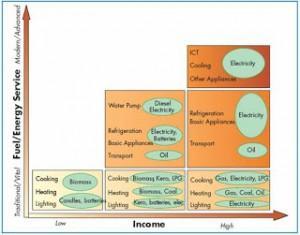 Just this week the IEA came out with their report that 2012 had the highest CO2 emissions on record, largely due to increases in CO2 emissions in China and the developing world which trumped lower CO2 emission in Europe and the US. This reminded me of what I see as the fundamental conundrum of sustainable development, and the reason that I got interested in all this green stuff in the first place:
Just this week the IEA came out with their report that 2012 had the highest CO2 emissions on record, largely due to increases in CO2 emissions in China and the developing world which trumped lower CO2 emission in Europe and the US. This reminded me of what I see as the fundamental conundrum of sustainable development, and the reason that I got interested in all this green stuff in the first place:
Poor people need to emit a lot (a whole lot) more carbon in order to develop their societies, and these emissions will exacerbate climate change.
They just do. It’s a fact. For a lot of environmentalists in the developed world, this is a tough and bitter pill to swallow. The mantra that the world cannot support everyone to use energy like Westerners do today is, of course, true, but it doesn’t mean that the aspirations of billions of people are going to slow down for even a second. They want the services (food refrigeration), status (motorbike, or car ownership), and excitement (road trips, karaoke machines) that can only be possible with modern energy services.
Billions of people are rightly struggling to move up in the world and as they do so they change the type of energy that they use moving from dirty and cheap fuels like biomass and candles towards more expensive and CO2 intensive fuels like coal, petroleum and natural gas. This movement through different types of fuel types is called the energy ladder by the folks at the International Energy Agency (below). Even if (a huge if) the rich part of the world really decided to commit economic suicide and drastically curb carbon emissions (laughably improbable) the world’s poor will continue to increase CO2 emissions as the move up the ladder. Thus the conundrum.
As I’ve come to understand it there are a limited number of ways to deal with this conundrum:
1. Do nothing. Always an option, and sadly the option that we as a species are choosing for the most part. By doing nothing (or not enough) to recognize the importance of the energy / development conundrum, I think we really risk the survival of our civilization. Doing nothing means dealing with the more drastic symptoms of climate change and all of the drama and terror that goes along with it. However doing nothing could also mean more global economic equity as that there will be more human development in the poor parts of the world as natural resources are converted into human and capital resources– assuming that the resultant pollution, megastorms, and sea-level rise doesn’t jeopardize all development wholesale.
2. Economic Political fix. The economic political fix centers on using governments’ unique power to ability to tax, subsidize, penalize, mandate, and decree carbon emission reductions. Meaningful CO2 emission cutting legislation would include taxing carbon emissions or setting up large scale and effectively administered carbon emission trading schemes. Europe has made more progress than the US. Large scale, legally binding and enforceable international agreements between the rich and poor countries on who should cut how much have stalled (nosedived?) spectacularly and given the ironclad connection between emissions and economic development the likelihood of a grand political fix ithat’s actually enforceable s becoming quixotic.
3. Technological fix. Closely related to the economic political fix, the technological fix is appealing to those who are alarmed by the energy / human development conundrum and have the cash to do something about it and recognize that the slow pace of political action isn’t enough. In this route, the world’s poor still move their way up the energy ladder toward electricity, but the electricity need is generated through renewable sources, or somehow the carbon released via unclean sources is reclaimed through carbon sequestration (see: the myth of clean coal). A lot of people have faith in the technological fix because it helped us, as a civilization dodge the agricultural conundrum between human reproduction and agricultural production that haunted Thomas Malthus. But choosing the tech fix path for the energy / human development conundrum, we don’t really have to change our behavior or societies very much; the innovative and capital classes do the heavy lifting and earn the profits from it. Whether the tech fix is enough is a huge question.
4. Organic Behavioral fixes. The behavioral fix has two sides. On the one hand the behavior, norms, and values in the rich world could change dramatically to embrace in a way less carbon intensive lifestyles. The transition from a capitalist cultural hegemony to a green hippy paradise seems unlikely. Very unlikely. However you can see green shoots with the expansion of community gardens, websites like this one, mass movement by young people to urban areas etc. On the other hand, the traditional societies that are moving up the energy ladder could choose not to modernize their lifestyles and go back towards traditional ways of life. I’ve done a lot of traveling throughout the parts of Asia where the movement up the energy ladder is the fastest and nothing suggests that this is remotely likely. I’m sure the same could be said of Latin America or Africa as well.
Of course, any reader of this blog knows, that the there is progress on all fronts and the solutions will likely be a mix of all the above, but I have grave doubts that the speed of our actions to ameliorate the effects of the energy / human development conundrum have been fast enough to meet the challenge.
[photo credit: IEA, 2003]

